The Forbidden City – Hall of Supreme Harmony
Well, please join us for our second day in China’s capital city of Beijing! As I mentioned in yesterday’s post, our itinerary for the second day was quite sweet and succinct – The Forbidden City, Tiananmen Square, Jingshan Park and the Temple of Heaven. The good news is that we managed all of those sights, the bad news is that our feet are killing us.
Starting the day at around 8am, we took the subway to Tiananmen East and exited to street level. We briefly took in Tiananmen (hoping it was accessible, as it was not the previous night) before heading to the main gate of the former Palace.
To approach the palace from the south (Tiananmen) you must pass through the “Gate of Heavenly Peace” which then leads you north to the actual entrance to the Forbidden City, the “Meridian Gate”. The approach is reminiscent of many of the Ming tombs both nearby and in Nanjing – straight approaches with lots of space.
Outside the Gate of Heavenly Peace (from the east)
The ticket booth is actually a fair way inside the Forbidden City, even if you didn’t want to pay to enter, the trip is well worth it as far as the gates – though it is not terribly expensive, so you’d be crazy not to part with the 40 RMB ($7 AUD) to enter.
The place is huge. There’s no easier way to put it. Although smaller than the Summer Palace, there’s virtually no water features except for the outer moat and an inner river. Once you have crossed the bridge(s) it is almost a straight trek directly north through the most amazing halls and gateways you can imagine.
Map of the Forbidden City
The Palace Museum, also known as the Forbidden City, is about 500 years old and measures 750 meters in width (East-West) and 960 meters in length (North-South) with an area of about 720 square meters, which houses 8,707 rooms. Each palace within the city is surrounded by 10 meter high walls, which makes the place somewhat of a labyrinth.
Rob outside the Meridian Gate
The experience starts at the “Meridian Gate” which is a huge structure with three massive gates and flanked by two massive buttresses. Once inside the city, you are confronted by a massive open area called “Taihemen Square” which is defended by a (normally running) stream crossed by stone bridges (“Inner Golden Water Bridge”). This leads to the second imposing gate, although not as large as the Meridian Gate, the “Gate of Supreme Harmony”. The square is massive and the approach to the gate is flanked by large stone dragons laced with gold.
Taihemen Square – Note the bridges in the foreground
You can not enter the gate, but have to pass through either the “Zhendu Gate” (west) or the “Zhaode Gate” (east) which are parallel with the main gate. Moving around the gate, your next encounter is the “Taihedian Square” which is another huge area marked prominently by the imposing “Hall of Supreme Harmony” which was one of the principal halls used by Emperors for ceremonial matters.
Hall of Supreme Harmony
This hall is then followed by two more great halls, the “Hall of Middle Harmony” (in the middle, ironically) and finally the “Hall of Preserving Harmony” which is apparently the largest wooden structure in China today. Following through the great halls, you are left at a large square – “Qian Men Square” – which is presided upon by the equally imposing “Gate of Heavenly Purity” which guards a walled inner sanctum.
Hall of Middle Harmony (front) and the Hall of Preserving Harmony (rear)
We passed through the “Palace of Heavenly Purity” and the “Palace of Earthly Tranquility” to arrive at the very interesting Imperial Garden, adorned by many fascinating looking trees and rock formations, the highlight being the “Gathering Beauty Hill” a building atop many of the massive rocks. We ended up going west and backtracking east as we explored various ways to head back south.
Gathering Beauty Hill / Massive stone carving on the exterior of the Hall of Preserving Harmony
There were so many additional buildings, halls and walkways that I couldn’t recount it all with much luck here. I can tell you that we made it to the Treasure Gallery on the eastern side of the city, which housed much more than treasure. There was a brilliant three story building which served as a private stage for plays to be performed for royalty, which contained intricate mechanisms for changing stage material and so on.
Private Stage / Model demonstrating the mechanics of the stage
We also passed through areas in which the last Emperor, Puyi, lived in during his brief reign. Many of his personal possessions are on display as well as some of the items of the Dowager Empress, Cixi, who ruled the country from behind the throne in the late 19th century.
We spent nearly four hours inside the palace, between 9am and 12:30pm, and would have been lucky if we’d seen two thirds of the place (well, those parts which were accessible to tourists). The back half of the grounds is a bit of a maze of halls and side streets, it could be quite easy to get lost weaving around those streets.
Long road separating the Treasure Gallery / Roof of the Pavilion of Floating Green in the Imperial Garden
Eventually we exited through the “Gate of Divine Prowess” and made our way north climbing up Jingshan Park’s rather steep hill where we took photos of the Forbidden City from a distance. Afterwards, we exited and went west where we found a small Chinese local restaurant. The other customers were delighted to hear us speaking Mandarin.
The North Exit – “Gate of Divine Prowess” / Looking south from Jingshan Park
After lunch (noodle beef soup, rice and spicy beef washed down with hot coffee milk tea), we walked back south to Tiananmen Square, where we took photos. We couldn’t visit with Mao’s mausoleum because they had modified opening hours due to the Jan 2-3 holiday ‘disturbance’ – a prominent problem across the city.
Tiananmen Square looking south
We decided to head to the sub way and made our way to the “Temple of Heaven” complex in the south which is a Taoist temple complex which used to be used by Ming and Qing emperors. We basically went straight to the major features, predominantly the Hall of prayer for good harvest, the Imperial vault of heaven and the circular mound altar. By the end, we were dead tired, and decided around 5pm to return to the hotel.
Hall of Prayer for Good Harvest at the Temple of Heaven
Once back near the hotel we had to find a supermarket to pick up some supplies for tomorrow’s hike around the Great Wall. We spent some time finding a local supermarket before retiring to the hotel (after a guilty snack at the nearby McDonalds!). Now it’s time for a shower, a rest and then some decision making regarding dinner.
Beijing Subway : Eat Fresh
Tomorrow we will hike across the Great Wall!
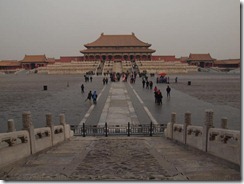



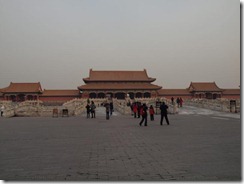

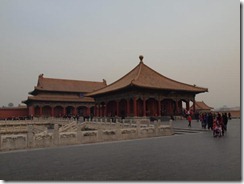
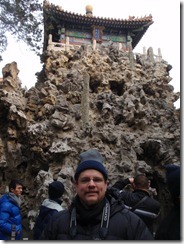
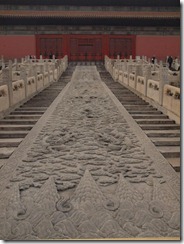
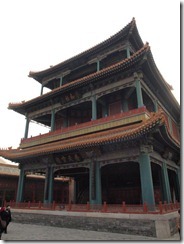


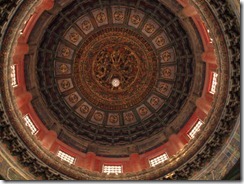
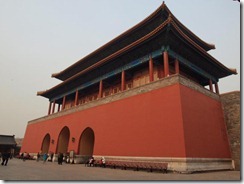

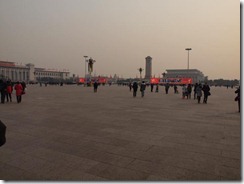

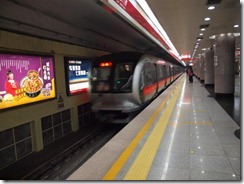
Who is the Michelin man?